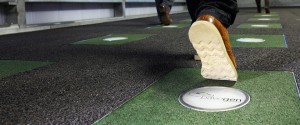Tiles that generate electricity when players step on them are providing some of the energy to floodlight a football pitch in Nigeria.
The rest of the power comes from solar panels. The facility, at the Federal College of Education in Lagos, is described as Africa’s first human and solar powered football pitch.
Around 90 under-pitch tiles capture kinetic energy created by the movement of players. The energy is stored and combined with power generated by solar panels to operate the new floodlights. The initiative allows the students to play at night.
Despite its plentiful supply of oil, Nigeria is very short of energy to power the lives of ordinary citizens. There is often just a few hours of power a day, and electricity supply is erratic. People are forced to rely on heavily polluting generators, and lighting a pitch at night is a luxury, even with fossil fuel.
The tiles, the revolutionary part of the package, come from British tech startup Pavegen. Every time a player steps on one, seven watts of electricity is generated and sent to a battery. The stored power feeds six powerful, low consumption LED floodlights that shine on the pitch. Solar panels around the pitch complement the technology, generating electricity throughout the day. Oil company Shell funded the Lagos floodlighting scheme.
Pavegen, a UK company at the leading edge of the (kinetic harvesting) business, was founded in 2009. The product is radical yet simple, no more than a rubber tile 45 x 60 centimeters. When someone steps on it, the tile bends slightly, around 5 millimeters. The energy generated by the footstep is “harvested”, and converted into electricity – about 7 watts per footstep.
A few kinetic tiles might be enough to power a street lamp on a relatively busy street. The technology could be useful anywhere from the centre of London to a remote off-grid tourist site, powered cleanly by the people who visit it.
Ten tiles can power a street light through the night. There are now over 100 Pavegen installations in around 30 countries, in train stations, shopping centres, airports and public spaces, mainly small scale trial schemes. Most involve no more than tens or, at the most, hundreds of tiles.
One of the busiest installations is in London Heathrow’s Terminal 3 where the energy from the footsteps of passing pedestrians on 51 tiles powers LED lights in a busy corridor.
Pavegen’s founder and CEO Laurence Kemball-Cook believes advances in kinetic harvesting in five years have equalled the progress solar power made over the first 20 years of its development.

